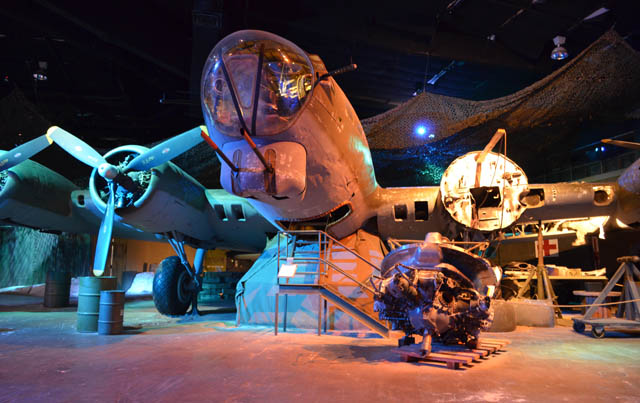
You are here: Home / Aircraft / Kermit's Collection / WWII / 1945 Boeing B-17 Flying Fortress
1945 Boeing B-17 Flying Fortress
Upon the entry of the U.S. into World War II, the B-17 Flying Fortress played a vital role in the bombardment of Germany. Flying out of American bases in England, as many as a thousand B-17 aircraft at a time were staged and deployed in daring daylight raids.
Designed in 1934, the Boeing B-17 was the first bomber to use four engines. When the first prototype rolled out in 1935, one newsman—seeing all of the guns protruding from everywhere—called it a “Flying Fortress.” The name forever stuck.
In the earliest days of the war, the long distance bombers flew steadfast to their targets, even when their fighter defense had to turn back for fuel, which required the bombers to operate in tight formation for protection—and resulted in a loss rate up to 25%. Even so, enemy fighters attacked the legendarily durable B-17 knowing that thirteen .50 caliber guns awaited them.
Eventually, the development of the long-range P-51 Mustang granted the Flying Fortress a mean escort at its side, allowing the bombers to deliver their payloads with greater safety to the crews and truly turn the tide of the war in Europe. This famous aircraft has justifiably achieved its enduring mythical status as a tough bird that couldn’t be beat.
On display courtesy of the World’s Greatest Aircraft Collection
Specifications
- Year Built — 1945
- Wingspan — 104′
- Cruise Speed — 150 mph
- Top Speed — 287 mph
- Gross Weight — 65,000 lbs
- Engine — Four Wright 1820 (1200 hp)
Kermit’s Comments
When you walk through the Flying Fortress that is part of Fantasy of Flight’s Immersion Experience display, the sounds you hear were recorded were recorded inside a genuine flying B-17. There are four separate sound tracks as you walk through the aircraft, and each of these was recorded in each actual location of a flying aircraft. With the sound vibrating the fuselage, you get a very real sense of what it is like to fly in a real B-17. Many a B-17 veteran has come out of this display with a tear in his eye.
In this Section
- Currently Showing In Museum
- Kermit’s Collection
- Early Flight
- WWI
- Golden Age
- 1938 AVRO Cadet
- 1934 Brown B-2 “Miss Los Angeles”
- 1937 Bücker Jungmeister
- 1934 Cierva C.30-A Autogiro
- 1929 Curtiss Robin
- 1931 Curtiss-Wright Junior
- 1932 DGA-5 “IKE”
- 1929 Ford 5AT Tri-Motor
- 1932 Gee Bee R-2
- 1931 Gee Bee Y Sportster
- 1931 Gee Bee Z
- 1931 Laird Super Solution
- 1934 Pitcairn Autogiro PA-18
- 1930 Sikorsky S-39
- 1927 Spirit of St. Louis
- 1931 Stinson Tri-Motor
- 1941 Stinson Vultee L-1E
- 1929 Travel Air 4000
- WWII
- 1944 Bachem Natter Viper
- 1945 Boeing B-17 Flying Fortress
- 1939 Bücker Bestmann
- 1936 Bücker Jungmann
- 1945 Chance-Vought F4U-4 Corsair
- 1944 Consolidated B-24J Liberator
- 1944 Curtiss TP-40N
- 1944 Fieseler V-1 Buzz Bomb
- 1937 Fieseler Fi-156 Storch
- 1937 Focke-Wulf Fw-44 Stieglitz
- 1938 Grumman F3F-2
- 1943 Grumman Wildcat
- 1940 Martin B-26 Marauder
- 1945 Nord Stampe
- 1944 North American AT-6
- 1943 North American B-25 J Mitchell
- 1944 North American P-51C Mustang
- 1945 Piper L-4 Grasshopper
- 1954 Polikarpov PO-2
- 1944 Short Sunderland
- 1945 Supermarine Spitfire Mk 16
- Korean War / Post WWII
- World’s Greatest Aircraft Collection